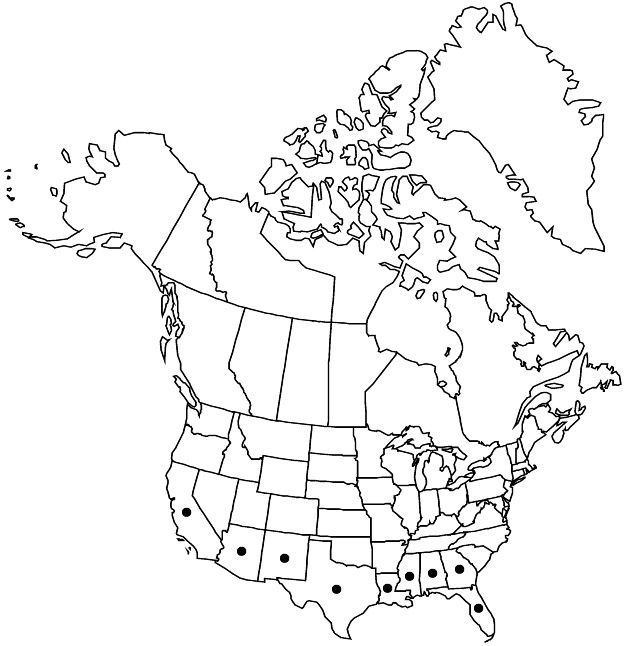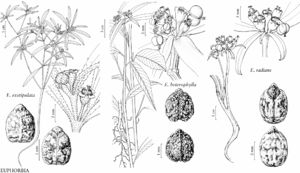Difference between revisions of "Euphorbia heterophylla"
Sp. Pl. 1: 453. 1753.
FNA>Volume Importer |
imported>Volume Importer |
||
| (4 intermediate revisions by 2 users not shown) | |||
| Line 16: | Line 16: | ||
}}{{Treatment/ID/Special_status | }}{{Treatment/ID/Special_status | ||
|code=F | |code=F | ||
| − | |label= | + | |label=Illustrated |
}} | }} | ||
|basionyms= | |basionyms= | ||
| Line 22: | Line 22: | ||
|name=Euphorbia geniculata | |name=Euphorbia geniculata | ||
|authority=Ortega | |authority=Ortega | ||
| + | |rank=species | ||
}} {{Treatment/ID/Synonym | }} {{Treatment/ID/Synonym | ||
|name=Poinsettia geniculata | |name=Poinsettia geniculata | ||
|authority=(Ortega) Klotzsch & Garcke | |authority=(Ortega) Klotzsch & Garcke | ||
| + | |rank=species | ||
}} {{Treatment/ID/Synonym | }} {{Treatment/ID/Synonym | ||
|name=P. heterophylla | |name=P. heterophylla | ||
|authority=(Linnaeus) Klotzsch & Garcke | |authority=(Linnaeus) Klotzsch & Garcke | ||
| + | |rank=species | ||
}} | }} | ||
|hierarchy=Euphorbiaceae;Euphorbia;Euphorbia sect. Poinsettia;Euphorbia heterophylla | |hierarchy=Euphorbiaceae;Euphorbia;Euphorbia sect. Poinsettia;Euphorbia heterophylla | ||
| Line 43: | Line 46: | ||
|elevation=0–500 m. | |elevation=0–500 m. | ||
|distribution=Ala.;Ariz.;Calif.;Fla.;Ga.;La.;Miss.;N.Mex.;Tex.;Mexico;Central America;South America;introduced also in Eurasia;Africa. | |distribution=Ala.;Ariz.;Calif.;Fla.;Ga.;La.;Miss.;N.Mex.;Tex.;Mexico;Central America;South America;introduced also in Eurasia;Africa. | ||
| + | |introduced=true | ||
|discussion=<p><i>Euphorbia heterophylla</i> occurs from the southern United States, where it is likely naturalized, south through Mexico and Central America to South America. Because of its weediness, the precise native range in tropical and subtropical parts of the New World is not well understood. It has become widely established also in warm areas of the Old World. Leaf shape in this species is highly polymorphic within both populations and individuals. <i>Euphorbia heterophylla</i> can appear superficially similar to <i>E. cyathophora</i> but differs in its stipitate, circular involucral glands and its floral bracts that are at most very pale at the base (never colored as is typical in <i>E. cyathophora</i>).</p> | |discussion=<p><i>Euphorbia heterophylla</i> occurs from the southern United States, where it is likely naturalized, south through Mexico and Central America to South America. Because of its weediness, the precise native range in tropical and subtropical parts of the New World is not well understood. It has become widely established also in warm areas of the Old World. Leaf shape in this species is highly polymorphic within both populations and individuals. <i>Euphorbia heterophylla</i> can appear superficially similar to <i>E. cyathophora</i> but differs in its stipitate, circular involucral glands and its floral bracts that are at most very pale at the base (never colored as is typical in <i>E. cyathophora</i>).</p> | ||
|tables= | |tables= | ||
| Line 52: | Line 56: | ||
-->{{#Taxon: | -->{{#Taxon: | ||
name=Euphorbia heterophylla | name=Euphorbia heterophylla | ||
| − | |||
|authority=Linnaeus | |authority=Linnaeus | ||
|rank=species | |rank=species | ||
| Line 67: | Line 70: | ||
|publication title=Sp. Pl. | |publication title=Sp. Pl. | ||
|publication year=1753 | |publication year=1753 | ||
| − | |special status=Weedy;Introduced; | + | |special status=Weedy;Introduced;Illustrated |
| − | |source xml=https:// | + | |source xml=https://bitbucket.org/aafc-mbb/fna-data-curation/src/2e0870ddd59836b60bcf96646a41e87ea5a5943a/coarse_grained_fna_xml/V12/V12_793.xml |
|genus=Euphorbia | |genus=Euphorbia | ||
|section=Euphorbia sect. Poinsettia | |section=Euphorbia sect. Poinsettia | ||
Latest revision as of 19:17, 5 November 2020
Herbs, annual, with taproot. Stems erect-ascending, 20–100 cm, sparsely pilose to villous; branches ± straight. Leaves usually alternate, occasionally opposite proximally; petiole 10–50 mm, pilose; blade narrowly lanceolate to elliptic or broadly obovate (then usually pandurate and 4-lobed), often polymorphic on single plants, 30–200 × 20–140 mm, base acute, margins sparsely glandular-serrulate, hirtellous, flat, apex acute to obtuse, abaxial surface sparsely appressed-pilose, adaxial surface sparsely pilosulous to glabrate; venation pinnate, midvein prominent. Cyathial arrangement: terminal dichasial branches usually 2, occasionally reduced to congested cyme, 1–2-branched (often congested and difficult to discern); pleiochasial bracts 2–4, often whorled, wholly green or paler green at base, similar in shape and size to distal leaves; dichasial bracts highly reduced, rarely absent in highly congested clusters. Cyathia: peduncle 0.9–1.5 mm. Involucre usually campanulate, occasionally nearly hemispheric, 1.5–1.9 × 1.2–1.8 mm, glabrous; involucral lobes divided into several linear, smooth lobes; gland 1, yellow-green, stipitate, clavate, 1–1.4 × 1–1.2 mm, opening circular (occasionally flattened from pressing), with annular rim, glabrous; appendages absent. Staminate flowers 8–15. Pistillate flowers: ovary glabrous or puberulent; styles 0.8–1.3 mm, 2-fid 1/2 to nearly entire length. Capsules broadly ovoid, 2.8–3.8 × 4–5.3 mm, 3-lobed, usually glabrous, rarely sparsely puberulent; columella 2.1–2.8 mm. Seeds brown-gray to ashy gray, broadly deltoid, 2.4–2.8 × 1.9–2.4 mm, angular in cross section, dorsal face strongly acute-carinate, tuberculate, with broad rounded tubercles in 2 rows; caruncle 0.1 mm. 2n = 28.
Phenology: Flowering and fruiting nearly year-round.
Habitat: Disturbed areas, roadsides.
Elevation: 0–500 m.
Distribution

Introduced; Ala., Ariz., Calif., Fla., Ga., La., Miss., N.Mex., Tex., Mexico, Central America, South America, introduced also in Eurasia, Africa.
Discussion
Euphorbia heterophylla occurs from the southern United States, where it is likely naturalized, south through Mexico and Central America to South America. Because of its weediness, the precise native range in tropical and subtropical parts of the New World is not well understood. It has become widely established also in warm areas of the Old World. Leaf shape in this species is highly polymorphic within both populations and individuals. Euphorbia heterophylla can appear superficially similar to E. cyathophora but differs in its stipitate, circular involucral glands and its floral bracts that are at most very pale at the base (never colored as is typical in E. cyathophora).
Selected References
None.
